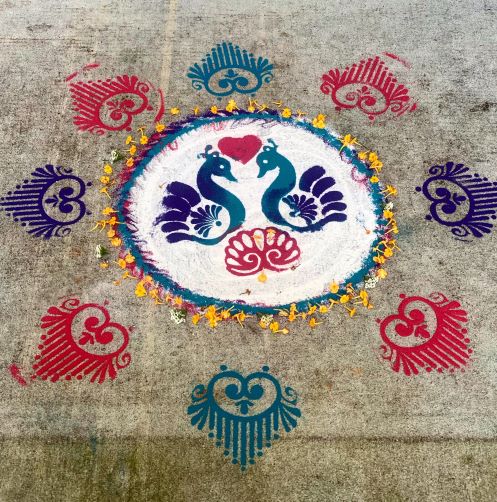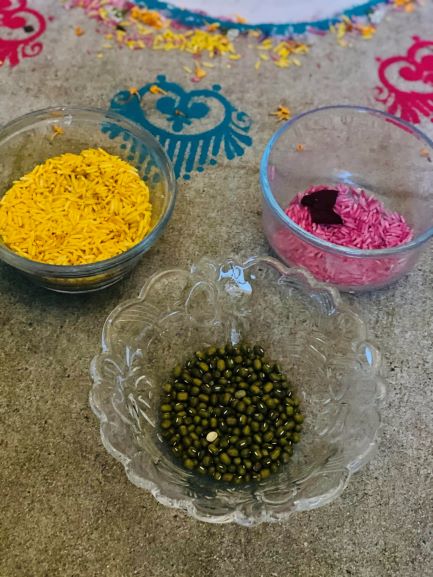Rangoli a Traditional Art Form of India That Customarily Used Colored Rice
Traditionally, Rangoli is an fine art of ornamentation drawn on the floor or the entrances of homes. It is thought to bring good luck, prosperity on the house and in the family, and to welcome guests.
Some mothers in India do this activity every morn, or on a special festive occasion similar Diwali, Onam, and Pongal. It is a folk art that is passed from one generation to another equally mothers teach the art of Rangoli to their kids.
Each land of India has its own way of making Rangoli and they are called past different names.
In South India, Rangoli is known as Kolam. In Rajasthan, the Mandana are drawn on walls. In Kolkata, Alpana is fatigued in the courtyard. In Maharashtra, Rangoli is drawn on the floor. Chowk Purana in Uttar Pradesh and Aripan in Bihar refer to decorating the floor with diverse blueprint using flour and rice paste.
Rangoli design can exist simple geometric shapes, floral shapes or they tin also be very elaborate designs. Some common symbols used in Rangoli are peacocks, lotus flowers, mangoes, and fish. The most of import element of Rangoli is beingness colorful!
Rangoli can exist made on the floor, sidewalk, or entrances of homes. The materials used tin easily be constitute in your pantry, 1000, or a regular grocery store. Typical materials include rice flour (either plain or dyed), equally well every bit lentils and beans to feed birds and ants. Rangoli is supposed to be meaningful to others, from honored guests to the smallest creatures, as well every bit being beautiful.
 Here are a few things y'all tin use for your Rangoli:
Here are a few things y'all tin use for your Rangoli:
- Colorful Flower petals
- Rangoli Powder/Chalk Powder
- Colored Raw Rice
- Raw Beans/Raw Lentils
- Raw Colorful Pasta
- Rice Pulverisation
- Common salt or Epsom Salt
- Rangoli tools (optional)
-
Utilise items available at home like plates, bowls, bottle caps, or bangle bracelets to create perfect circumvolve designs. Use a paint brush tip or Q-tips to fill in the finer details.
-
Make full an empty common salt/pepper shaker with Rangoli colors for an piece of cake shaker to fill in the pattern.
-
To make colorful rice, pasta, or salt: measure out 1 cup of rice, pasta, or salt into a container that comes with a lid (or a sealable bag). Add food coloring and 1 teaspoon of vinegar. Put the hat on the container or seal the top of the handbag, and shake everything up until the color is evenly distributed. Spread the textile in an fifty-fifty layer on a paper plate or towel until dry. For faster drying, spread materials on a sheet tray and put in the oven at a low temperature, stirring occasionally until dry.
How to Make Rangoli
- Choose the design you lot want to brand -- either geometrical, a floral blueprint, or get creative and follow wherever your inspiration leads you!
- Decide where to depict your Rangoli. You tin draw on the floor or outside of your house.
- Requite dimension to your outline with white textured material like rice flour, Rangoli powder or chalk pulverisation. Rice flour/Rangoli Powder is usually applied free mitt by letting it run from the gap formed by pinching the thumb and forefinger.
- Choose the materials you will use to fill in the design. Employ natural materials easily found in your firm or garden. You tin can use bloom petals, leaves, colored rice, chalk or Rangoli powder, beans etc.
Snap a picture and share your creation with u.s.a. on social media using #ilearnbecause
Inspired by this activity? Check out these additional resources:
- The Culture and Crafts of India -- colorful photographs and informative text introduce young readers to the civilisation of India, forth with step-by-step instructions for related arts and crafts projects
- The Best of Bollywood -- 15 classic hits from the Indian cinema
- Indian Cooking Unfolded -- a master class in Indian cooking, with 100 piece of cake recipes using ten ingredients or less
- Interpreter of Maladies -- stories by Jhumpa Lahiri about Indians living in Bharat and in America
Source: https://www.richlandlibrary.com/blog/2020-07-15/rangoli-creative-expression-indian-folk-art-through-use-colors
0 Response to "Rangoli a Traditional Art Form of India That Customarily Used Colored Rice"
Postar um comentário